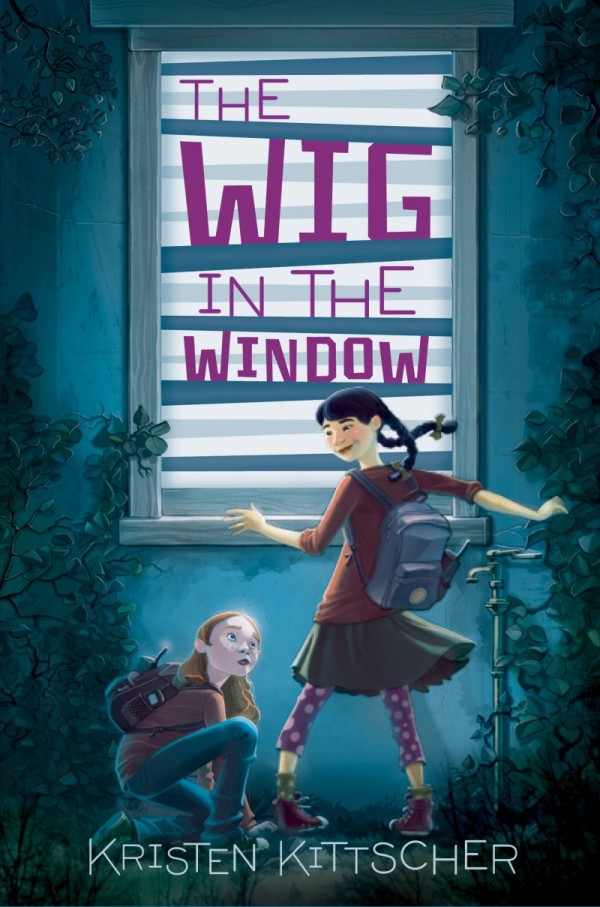
Kristen Kittscher is the author of “The Wig in the Window.” The following is a complete transcript of her interview with Cracking the Cover.
Have you always wanted to be a writer?
My chief career goal in early life was to be a cab driver – imagine! Driving cars all day! That didn’t preclude me from imagining new future occupations for myself almost weekly: astronaut, dentist, veterinarian, business tycoon, inventor. Eventually, though, I must’ve realized that being a writer and telling stories offers the possibility to be just about anything, thanks to the power of imagination.
I was forever making up stories as a kid, even if I didn’t specifically express that I wanted to be a writer. I still have a notebook of stories I wrote at age six. It seems I had an unfortunate passion for pretend-French-speaking cats! (Kids should be careful what they wish for, by the way: I might not be a cab driver now, but living in traffic-congested L.A. certainly gives me a taste of it!)
Despite a life-long love of telling stories, I didn’t have the courage to take writing seriously until I started THE WIG IN THE WINDOW. I thought of it as something people infinitely more talented and special could do professionally, so I was embarrassed to admit to myself that I wanted to write. It felt impractical to take time away from other things to throw myself into fiction. Instead I found ways to satisfy my passion for stories and language in other ways—by developing scripts in Hollywood, by working for a translation company, and by teaching English. I wrote long letters and emails to friends, I wrote in a journal, I helped others with writing. It took a long time to believe in myself enough to commit to writing a novel.
Why write for young readers? / Where did the idea for “The Wig in the Window” come from? [Combining these two, Jessica, as they go together for me.]
My very clever, funny seventh grade English students at the all-girls’ school where I taught for six years were my muse for THE WIG IN THE WINDOW. I’d long wanted to write a novel, but it wasn’t until I thought of creating a story that would entertain kids like them that I finally threw myself into the project. It helped that one of my students had loaned me Kirsten Miller’s KIKI STRIKE: INSIDE THE SHADOW CITY. I loved how Miller didn’t shy away from high stakes or talk down to her young readers – it gave me a sense of the possibilities when writing for kids!
The story itself was born when I stumbled across some (heavily autobiographical!) old snippets of a free-writing exercises in which an adult main character reminisces about her sixth grade exploits as a neighborhood spy. It was fun material—and I wondered what it might sound like from a kid’s point of view. I scrawled a note then: “Nancy Drew meets Rear Window?” and further down on the page, another, “cozy mystery for kids.”
I knew, too, that I wanted to write a story that would portray the ups and downs of middle school friendship at this time when kids are caught in between wanting to be more mature and trying to hang onto their childhood innocence a little longer. At the heart of the novel is how Young & Yang navigate the tensions in their friendship as they undertake increasingly dangerous investigations.
 Were you as inquisitive as Sophie and Grace when you were a child?
Were you as inquisitive as Sophie and Grace when you were a child?
I’m still as inquisitive now! Careful…I may have just bugged your cell phone!
The childhood spy games I played as a kid with my best friend were more about inventing stories than inquisitiveness—and making super cool ID badges, of course. Nothing says “undercover spy” like official identification cards with photos.
I was very inquisitive in general, however. Like Sophie Young, I had a lot of passing phases of intense interest: there was the time I read a biography of Henry Diesel, then wanted to build my own engine for my bike; then there was the period I was very into the idea of astral projection; I wanted to be a jazz trumpeter for a while. My parents didn’t like that phase so much.
How did you come up with the Sophie and Grace’s hijinks?
I wish I had a satisfying answer for that. When people ask about the creative process, I keep thinking of a question-and-answer session I saw with Judy Blume once. When someone asked her how she started her stories, she looked utterly flummoxed. “I start with a…” She paused scratched her head. “I start with a…what?” I feel the same way when I think about how I invented Sophie and Grace’s hijinks. Mostly, I tried to follow a chain of logic: if x happens, what would these two enterprising sleuthing friends do and think next? I guess hijinks come after character for me, even though mysteries are plot-driven.
What was your favorite part of writing “The Wig in the Window”?
Watching the characters develop was my favorite part of writing WIG. There’s nothing better than surprising yourself when writing—when a witty line or suspenseful twist seems to come out of nowhere onto the page. I savor those moments still.
The Wig in the Window is a funny mystery, but it’s also about Sophie Young finding her inner boldness and her voice—taking herself seriously, at last. Thematically, her journey parallels my own as a new writer. I’m still discovering what I have in me—and, hopefully, there are lots of new discoveries to make.
What makes “The Wig in the Window” stand out from its contemporaries?
I joke that The Wig in the Window is really a psychological thriller more than a mystery, which must put it in the minority of kids’ books. I chuckled when Betsy Bird reported back a first impression of WIG from the HarperCollins preview: “You’ve gotta kind of respect a middle grade novel that begins with the heroines convinced they’ve just watched their guidance counselor killing someone only to find that she was merely making pickled beets,” she said. Her summary touches upon what makes WIG unique, though: it’s a book that gives kids a fun, over-the-top ride with thrilling life-or-death stakes—but it’s still a safe, wholesome read. Sometimes it seems like there’s a gap in reading options for kids who want more sophisticated plots and high stakes but aren’t really ready for Hunger Games. I named my main character “Sophie Young,” because she exemplifies that in-between age: wise and young. And I think those are my readers, too.
What are you working on now?
A sequel to WIG is slated. The Tiara on the Terrace. In it, Young & Yang (and their new friend Trista Bottoms) go undercover as “Royal Pages” in their town parade, which is loosely based on Pasadena’s Rose Parade. I think of it as Miss Congeniality set in middle school. Even more hijinks and silliness in this one!
Looking back, how has your writing evolved?
At one point, I think I believed that being a good writer meant writing lovely sentences. I can write lovely sentences at times, but I’ve learned that all those lovely sentences mean nothing if you can’t create a satisfying whole. It’s an obvious lesson, but it wasn’t obvious to me.
Most of all, though, I think my attitude toward my own writing has evolved. I wasted a lot of time putting myself down—as if somehow I could protect myself from critique by being the first to judge myself harshly. I don’t think you can grow without being realistic about your limitations, but I took it to an extreme—and I definitely held myself back as a result. Fear’s still a hurdle for me, but at least I recognize that’s just part of the writing process.
Is there a particular book from your own childhood that still resonates with you today?
You know, so many do – I’m going to leave this question out and hope you have enough good material, as I’m just going to ramble and list far too many titles!
